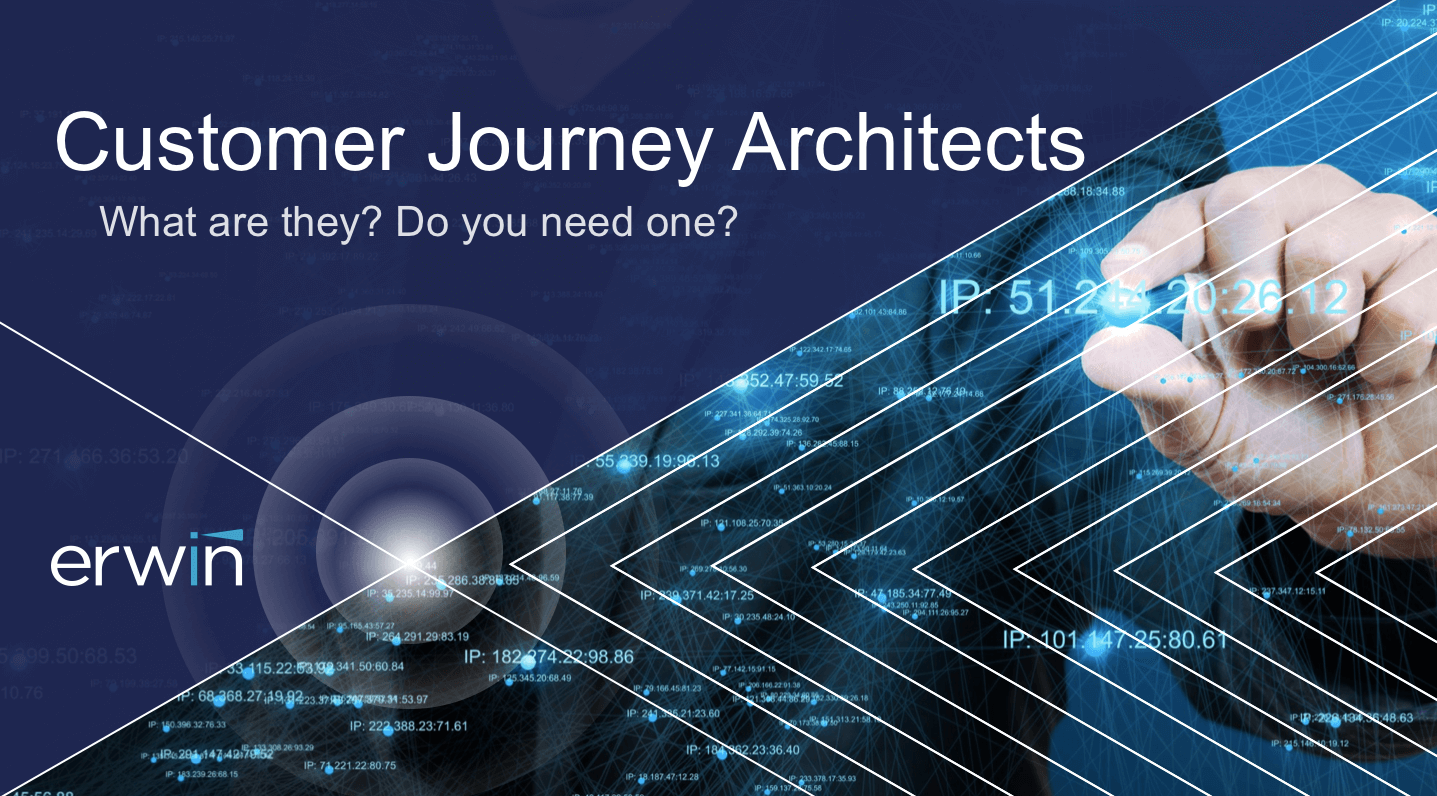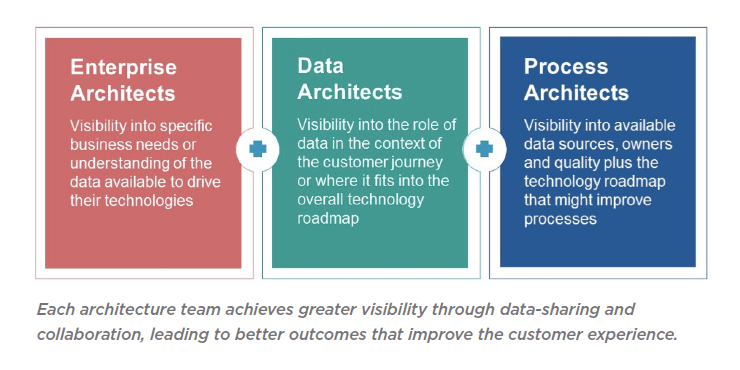Customer journey architects are becoming more relevant than ever before.
For businesses that want to make improvements, enterprise architecture has long been a tried and tested technique for mapping out how change should take place.

Customer journey architects are becoming more relevant than ever before.
For businesses that want to make improvements, enterprise architecture has long been a tried and tested technique for mapping out how change should take place.

Despite the nomenclature, enterprise architecture, data architecture and business process architecture are very different disciplines. Despite this, organizations that combine the disciplines enjoy much greater success in data management.
Both an understanding of the differences between the three and an understanding of how the three work together, has to start with understanding the disciplines individually:
Enterprise architecture defines the structure and operation of an organization. Its desired outcome is to determine current and future objectives and translate those goals into a blueprint of IT capabilities.
A useful analogy for understanding enterprise architecture is city planning. A city planner devises the blueprint for how a city will come together, and how it will be interacted with. They need to be cognizant of regulations (zoning laws) and understand the current state of city and its infrastructure.
A good city planner means less false starts, less waste and a faster, more efficient carrying out of the project.
In this respect, a good enterprise architect is a lot like a good city planner.
The Data Management Body of Knowledge (DMBOK), define data architecture as “specifications used to describe existing state, define data requirements, guide data integration, and control data assets as put forth in a data strategy.”
So data architecture involves models, policy rules or standards that govern what data is collected and how it is stored, arranged, integrated and used within an organization and its various systems. The desired outcome is enabling stakeholders to see business-critical information regardless of its source and relate to it from their unique perspectives.
There is some crossover between enterprise and data architecture. This is because data architecture is inherently an offshoot of enterprise architecture. Where enterprise architects take a holistic, enterprise-wide view in their duties, data architects tasks are much more refined, and focussed. If an enterprise architect is the city planner, then a data architect is an infrastructure specialist – think plumbers, electricians etc.
For a more in depth look into enterprise architecture vs data architecture, see: The Difference Between Data Architecture and Enterprise Architecture
Business process architecture describes an organization’s business model, strategy, goals and performance metrics.
It provides organizations with a method of representing the elements of their business and how they interact with the aim of aligning people, processes, data, technologies and applications to meet organizational objectives. With it, organizations can paint a real-world picture of how they function, including opportunities to create, improve, harmonize or eliminate processes to improve overall performance and profitability.
A successful data-driven business combines enterprise architecture, data architecture and business process architecture. Integrating these disciplines from the ground up ensures a solid digital foundation on which to build. A strong foundation is necessary because of the amount of data businesses already have to manage. In the last two years, more data has been created than in all of humanity’s history.
And it’s still soaring. Analysts predict that by 2020, we’ll create about 1.7 megabytes of new information every second for every human being on the planet.
While it’s a lot to manage, the potential gains of becoming a data-driven enterprise are too high to ignore. Fortune 1000 companies could potentially net an additional $65 million in income with access to just 10 percent more of their data.
To effectively employ enterprise architecture, data architecture and business process architecture, it’s important to know the differences in how they operate and their desired business outcomes.
Historically, these three disciplines have been siloed, without an inherent means of sharing information. Therefore, collaboration between the tools and relevant stakeholders has been difficult.
To truly power a data-driven business, removing these silos is paramount, so as not to limit the potential analysis your organization can carry out. Businesses that understand and adopt this approach will benefit from much better data management when it comes to the ‘3 Vs.’
They’ll be better able to cope with the massive volumes of data a data-driven business will introduce; be better equipped to handle increased velocity of data, processing data accurately and quickly in order to keep time to markets low; and be able to effectively manage data from a growing variety of different sources.
In essence, enabling collaboration between enterprise architecture, data architecture and business process architecture helps an organization manage “any data, anywhere” – or Any2. This all-encompassing view provides the potential for deeper data analysis.
However, attempting to manage all your data without all the necessary tools is like trying to read a book without all the chapters. And trying to manage data with a host of uncollaborative, disparate tools is like trying to read a story with chapters from different books. Clearly neither approach is ideal.
Unifying the disciplines as the foundation for data management provides organizations with the whole ‘data story.’
The importance of getting the whole data story should be very clear considering the aforementioned statistic – Fortune 1000 companies could potentially net an additional $65 million in income with access to just 10 percent more of their data.
Download our eBook, Solving the Enterprise Data Dilemma to learn more about data management tools, particularly enterprise architecture, data architecture and business process architecture, working in tandem.
Instead of utilizing built for purpose data management tools, businesses in the early stages of a data strategy often leverage pre existing, make-shift software.
However, the rate in which modern businesses create and store data, means these methods can be quickly outgrown.
In our last post, we looked at why any business with current, or future plans for a data-driven strategy need to ensure a strong data foundation is in place.
Without this, the insight provided by data can often be incomplete and misleading. This negates many of the benefits data strategies are typically implemented to find, and can cause problems down the line such as slowing down time to markets; increasing the potential for missteps and false starts; and above all else, adding to costs.
Leveraging a combination of data management tools, including data modeling, enterprise architecture and business processes can ensure the data foundations are strong, and analysis going forward is as accurate as possible.
For a breakdown of each discipline, how they fit together, and why they’re better together, read on below:
This post is part two of a two part series. For part 1, see here.
Data Modeling
Effective Data Modeling helps an organization catalogue, and standardize data, making the data more consistent and easier to digest and comprehend. It can provide direction for a systems strategy and aid in data analysis when developing new databases.
The value in the former is that it can indicate what kind of data should influence business processes, while the latter helps an organization find exactly what data they have available to them and categorize it.
In the modern world, data is a valuable resource, and so active data modeling in order to manage data, can reveal new threads of useful information. It gives businesses a way to query their databases for more refined and targeted analysis. Without an effective data model, insightful data can quite easily be overlooked.
Data modeling also helps organizations break down data silos. Typically, much of the data an organization possesses is kept on disparate systems and thus, making meaningful connections between them can be difficult. Data modeling serves to ease the integration of these systems, adding a new layer of depth to analysis.
Additionally, data modeling makes collaborating easier. As a rigorous and visual form of documentation, it can break down complexity and provide an organization with a defined framework, making communicating and sharing information about the business and its operations more straightforward.
Enterprise Architecture
Enterprise Architecture (EA) is a form of strategic planning used to map a businesses current capabilities, and determine the best course of action to achieve the ideal future state vision for the organization.
It typically straddles two key responsibilities. Those being ‘foundational’ enterprise architecture, and ‘vanguard’ enterprise architecture. Foundational EA tends to be more focused on the short term and is essentially implemented to govern ‘legacy IT’ tasks. The tasks we colloquially refer to as ‘keeping on the lights’.
It benefits a business by ensuring things like duplications in process, redundant processes, and unaccounted for systems and shelfware don’t cost the business time and money.
Vanguard enterprise architects tend to work with the long term vision in mind, and are expected to innovate to find the business new ways of reaching their future state objectives that could be more efficient than the current strategy.
It’s value to a business becomes more readily apparent when it enterprise architects operate in terms of business outcomes, and include better alignment of IT and the wider business; better strategic planning by adding transparency to the strategy, allowing the whole business to align behind, and work towards the future objective; and a healthier approach to risk, as the value (reward) in relation to the risk can be more accurately established.
Business Process
Business process solutions help leadership, operations and IT understand the complexities of their organizations in order to make better, more informed and intelligent opinions.
There are a number of factors that can influence an organization who had been making it by without a business process solution, to implement the initiative. Including strategic initiatives – like business transformation, mergers and acquisitions and business expansion; compliance & audits – such as new/changing industry regulations, government legislation and internal policies; and process improvement – enhancing financial performance, lowering operating costs and polishing the customer experience.
We can also look at the need for business process solutions from the perspective of challenges it can help overcome. Challenges including the complexities of a large organization and international workforces; confusion born of undefined and undocumented processes as well as outdated and redundant ones; competitor driven market disruption; and managing change.
Business process solutions aim to tackle these issues by allowing an organization to do the following:-
The Complete, Agile Foundation for the Data-Driven Enterprise.
As with data, these three examples of data management tools also benefit from a more fluent relationship, and for a long time, industry professionals have hoped for a more comprehensive approach. With DM, EA and BP tools that work in tandem with, and complement one another inherently.
It’s a request that makes sense too, as although all three data management tools are essential in their own right, they all influence one another.
We can look at acquiring, storing and analyzing data, then creating a strategy from that analysis’ as separate acts, or chapters. And when we bring the whole process together, under one suite, we effectively have the whole ‘Data Story’ available to us in a format we can analyze and inspect as a whole.